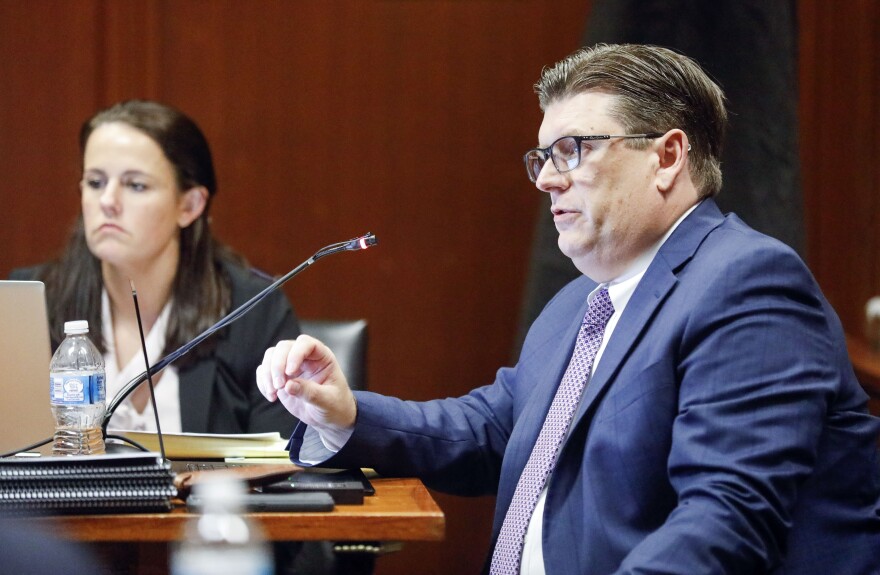A DNA analyst testified in court Friday that DNA consistent with Mollie Tibbetts’ was found in the car of the man accused of killing her. Prosecutors have said the evidence is among the key parts of their case against Cristhian Bahena Rivera, who faces a first degree murder charge in the death of the 20-year-old college student who went missing in 2018.
Building on previous testimony that Bahena Rivera admitted to leading investigators to Tibbetts’ body hidden in a cornfield in rural Poweshiek County, prosecutors used DNA evidence to establish that blood found in the suspect’s car contained DNA that matched Tibbetts’ own genetic profile.
Bahena Rivera has pleaded not guilty to a first degree murder charge in Tibbetts’ death. But investigators have testified that he admitted to following Tibbetts while she was running and becoming angry with her when she threatened to call the police.
Officers have testified that Bahena Rivera also admitted to taking Tibbetts’ body out of the trunk of his car and placing it in a cornfield, a remote location that he later led officers to.
In the course of searching Bahena Rivera’s black Chevy Malibu for potential evidence, crime scene analysts took swabs of stains found in the trunk of the car. Multiple stains were later determined to contain blood that was consistent with Tibbetts’ DNA.

“The screening test indicated the presence of blood on those swabs and the DNA profile that I developed matched the known DNA profile of Mollie Tibbetts,” testified Tara Scott, a DNA analyst with the Iowa Division of Criminal investigation. “The probability of finding this profile in a population of unrelated individuals chosen at random would be less than one out of 8.2 nonillion.”
“That’s a lot of zeros, correct? A very large number,” replied prosecutor Scott Brown. “That’s why you’re able to say that the swab that was taken in exhibit…or the swab that was taken from the blood stain in exhibit 46 matches that of Mollie Tibbetts’ known DNA?”
“Yes, the profile from…that I had for Mollie Tibbetts and the profile I developed from the blood matched,” Scott replied. “Exactly the same.”
Bahena Rivera’s defense attorneys have worked to cast doubt on this and other aspects of the state’s case, posing questions about proper handling of evidence and the potential for cross contamination.
Testimony includes graphic images of Tibbetts’ remains
Friday’s proceedings included testimony from a crime scene analyst who had been summoned to the cornfield in rural southeast Poweshiek County where officers had found human remains believed to be Tibbetts’.
In the days and weeks after Tibbetts went missing on the evening of July 18, 2018, friends, family, neighbors, law enforcement and volunteers undertook a massive search operation in the hopes of finding the University of Iowa student. She had been studying psychology and was known to be a loving daughter and caring friend with a heart for helping others.
Ultimately, officers say it was Bahena Rivera who led them to the cornfield where Tibbetts’ body was hidden. The farm hand had been questioned by officers for 11 hours after his vehicle was identified on security camera footage near Tibbetts’ suspected running route on the evening she disappeared.

During Friday’s testimony, prosecutors presented photos of the crime scene where the remains were found and diagrams drawn of the area.
“It was quite remote,” testified DCI crime scene analyst Amy Johnson. “There was a house to the east proximately half a mile and a house to the west approximately half a mile.”
Johnson testified that when officers located the body, it was significantly decomposed and largely covered by cornstalks, except for a pair of brightly colored running shoes.
“The area was…it had a little bit of a clearing,” she said. “There were bent over cornstalks covering what is the body. And so the bent over corn area allowed for a little bit of an opening in the corn.”
DNA testing would later confirm the human remains were Tibbetts’.
Johnson testified that there appeared to be fabric on the upper torso of the body, but nothing on the lower part. A pair of black shorts, some striped fabric believed to be underwear and pink fabric thought to be a headband were found in the vicinity of the body. No testing conducted by DCI analysts detected the presence of semen.
Defense attorneys show video of Bahena Rivera sleeping during police interview
Bahena Rivera’s defense team questioned police officer Pamela Romero at length Friday about her questioning of their client in August of 2018. Romero, who was with the Iowa City Police Department at the time, interviewed Bahena Rivera in Spanish along with ICPD officer Jeff Fink for some 11 hours on the evening of August 20 and into the early hours of the next morning.
It was then that Bahena Rivera led officers to the cornfield where Tibbetts’ body was found and recounted how he hid her there, telling officers “I did it," but that he couldn’t recall how he killed her.

His attorneys have been apparently laying the groundwork to argue that Bahena Rivera was sleep deprived and coerced into the making the statements. In questioning witnesses, they have posed multiple questions about “false confessions."
Attorney Jennifer Frese questioned Romero repeatedly about whether her client fell asleep during his interview with her, a point which Romero disputed again and again. Romero said she never saw him sleeping and that he was alert during her questioning.
Video footage and transcripts of the encounter presented to the jury showed that during breaks when Bahena Rivera was alone in the interview room, he repeatedly rested his head on the table and appeared to be asleep, and that he told officers he fell asleep.
Pool photographer ordered to leave courtroom
Before the lunch break Friday, District Judge Joel Yates seized a news camera and threatened to jail a photojournalist after she acknowledged taking photos of jurors during the day’s testimony, which is prohibited under Iowa court rules.
Due to coronavirus concerns, no members of the public or the media have been allowed inside the courtroom apart from a pool reporter and pool photographer, who supply text and photos to other journalists monitoring the proceedings remotely.
The photographer, who is with The Daily Iowan, the student newspaper at the University of Iowa, told Yates her editor had directed her to photograph the jurors and that she was unaware of the rule against it. She apologized, saying she was completely in the wrong. Yates asked whether he should jail her or her editor first.
The photojournalist deleted the photos in front of Yates and he confiscated her memory card, which he deemed to be sufficient to ensure no photos were published. He sent the photographer home and said she wouldn’t face further punishment. Yates briefed the jurors on the incident, assuring them that no photos of them would be released.
The trial will continue Monday, May 24 at the Scott County Courthouse at 8:30 a.m. Testimony is expected to conclude in a matter of days, with jurors possibly beginning their deliberations by the end of the week.





